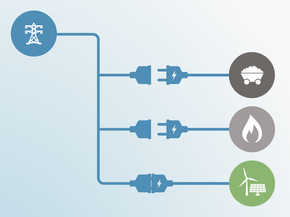Targets
Target Overview
Costa Rica’s December 2020 NDC includes a target of 9.11 MtCO2e emissions in 2030 and a cumulative emissions budget between 2021 and 2030 of 106.53 MtCO2e emissions (including LULUCF with global warming potentials, GWPs, from the IPCC’s Second Assessment Report, SAR). The CAT estimates the 2030 target to be 11.9 to 12.5 MtCO2e excluding LULUCF in GWPs from the IPCC’s fourth assessment report (see “Assumptions” section for details). For 2030, this is equivalent to a decrease between 7% to 11% below 2010 levels excluding LULUCF.
The CAT rates Costa Rica’s 2030 NDC target as “Almost Sufficient" when rated against modelled domestic pathways ("NDC target against modelled domestic pathways"), and "1.5°C compatible" when rated against the fair share contribution ("NDC target against fair share"). Costa Rica does not specify a conditional target or an international element in its NDC, so we rate the unconditional target against the two rating frameworks.
| COSTA RICA — Main climate targets |
|---|
| 2030 NDC target | |||
|---|---|---|---|
| Formulation of target in NDC | Costa Rica commits to absolute maximum net emissions in 2030 of 9.11 MtCO2e including all emissions and all sectors covered by the corresponding National Greenhouse Gas Emissions Inventory (Government of Costa Rica, 2020). | ||
|
Absolute emissions level in 2030 excl. LULUCF |
Level of emissions to be achieved at home: 11.9–12.5 MtCO2e [7–11% below 2010] |
||
| Status | Submitted in December 2020 | ||
| Net zero & other long-term targets | |||
|---|---|---|---|
| Formulation of target | Costa Rica commits to becoming a decarbonised economy with net-zero emissions by 2050 (Government of Costa Rica, 2019c). | ||
|
Absolute emissions level in 2050 excl. LULUCF |
5.5 MtCO2e [59% below 2010] |
||
| Status | Submitted in December 2019 | ||
NDC Updates
Costa Rica’s updated NDC, submitted on 30 December 2020, includes two unconditional targets: an absolute single year 2030 emissions target, and a multi-year emissions budget for 2021 - 2030. The absolute emissions target represents a 2% improvement on Costa Rica’s original NDC submitted in 2016.
Costa Rica’s NDC outlines various sectoral measures and targets but does not specify the sectoral breakdown. Specifying the sectoral breakdown or at least the contribution of the forestry sector to its target would improve the climate target’s transparency. Costa Rica’s NDC claims to be 1.5°C-compatible, however this is not substantiated in its submission.
| COSTA RICA — History of NDC updates | First NDC | 2020 NDC update |
|---|---|---|
| 1.5°C compatible |
|
|
| Stronger target | N/A |
|
| Economy-wide coverage |
|
|
| Fixed/absolute target |
|
|
| COSTA RICA | First NDC | 2020 NDC |
|---|---|---|
| Formulation of target in NDC | The country is committed to a maximum of 9,374,000 tCO2e net emissions by 2030 | Costa Rica commits to absolute maximum net emissions in 2030 of 9.11 MtCO2e including all emissions and all sectors covered by the corresponding National Greenhouse Gas Emissions Inventory (Government of Costa Rica, 2020). |
|
Absolute emissions level excl. LULUCF |
12.2–12.8 MtCO2e by 2030 | 11.9–12.5 MtCO2e by 2030 |
|
Emissions compared to 1990 and 2010 excl. LULUCF |
5-9% below 2010 emissions by 2030 | 7-11% below 2010 emissions by 2030 |
| CAT rating |
Overall rating*: 2°C compatible / Almost sufficient |
NDC target against modelled domestic pathways: Almost sufficient |
| Sector coverage | Economy-wide | Economy-wide |
| Separate target for LULUCF | No | No |
| Gas coverage | All greenhouse gases | All greenhouse gases |
| Target type | Absolute emissions reduction (single year target) | Absolute emissions reduction (single year target) |
* Before September 2021, all CAT ratings were based exclusively on fair share and only assessed a country’s target.
Target development timeline & previous CAT analysis
- 30.12.2022 Costa Rica submitted a stronger NDC target
CAT rating of targets
The CAT rates NDC targets against what a fair contribution to achieving the Paris Agreement’s long-term temperature goal would be as well as against what needs to happen within a country’s own borders. Developing countries like Costa Rica will need support to achieve emission reductions in line with a physically required pathway to achieving the 1.5°C long-term temperature goal.
Costa Rica has one NDC target. It has not specified whether a portion of the target is conditional on international support or whether its NDC has an international element, so we rate its NDC target against both fairness metrics and modelled domestic pathways.
CAT ratings are based on emissions excluding the LULUCF sector. To obtain the NDC emissions level excluding LULUCF, the CAT takes two estimates provided by the Costa Rican government and creates a range. For more details, please see the Assumptions section.
In the absence of a target conditional on international support, we rate Costa Rica’s 2030 NDC target as “Almost sufficient” when compared with modelled domestic emissions pathways. The “Almost sufficient” rating indicates that Costa Rica’s NDC target is not yet consistent with modelled domestic pathways limiting warming to 1.5°C but could be, with moderate improvements. If all countries were to follow Costa Rica’s approach, warming could be held below—but not well below—2°C.
Costa Rica’s updated climate target represents an improvement compared to its first NDC, however it is not stringent enough to limit warming to 1.5°C. To improve its rating and be consistent with the 1.5°C temperature limit, Costa Rica could submit a conditional 2030 climate target that is at least 7% lower than its current unconditional target (equivalent to an absolute emissions limit of 11 MtCO2e excl. LULUCF in 2030) and, if necessary, outline the international support that it would need to achieve it.
We rate Costa Rica’s 2030 NDC target as “1.5°C compatible” when compared with its fair-share contribution to climate action. The “1.5°C compatible” rating indicates that Costa Rica’s NDC target is consistent with its fair share of the global mitigation effort to limit warming to 1.5°C. Costa Rica’s NDC target does not require other countries to make comparably deeper reductions or greater effort and is in the most stringent part of its fair share range.
Further information on how the CAT rates countries (against modelled pathways and fair share) can be found here.
Net zero and other long-term target(s)
We evaluate the net zero target as Acceptable.
Costa Rica announced a net zero target for 2050 in its National Decarbonisation Plan 2018-2050 (Government of Costa Rica, 2019c). The net zero target covers most key elements but does not meet best practice standards for some of them.
Costa Rica’s target covers all sectors and gases underpinned by emissions pathway analysis and the communication of strategic goals and emissions targets per sector. Pathways and key measures are identified comprehensively with interim goals attributable to discernible periods to reach net zero through domestic actions and without the use of international credits.
The Costa Rican government does not provide explicit and transparent assumptions on some key elements. For example, Costa Rica provides no information on its intention to establish a formal periodic review cycle of measures and interim targets. To further improve its strategy, Costa Rica could provide separate targets for emission reductions and removals and include emissions from international bunkers. The policy document has also not yet been enshrined in law, which could make targets and measures legally binding and more robust.
In 2019, Costa Rica presented its National Decarbonisation Plan 2018-2050 (Government of Costa Rica, 2019c). In this document, Costa Rica sets a national target of net-zero emissions in 2050—emissions including LULUCF—and describes a roadmap towards achieving this target. According to the sectoral breakdown provided in the plan, emissions in 2050 will be 5.5 MtCO2e excluding LULUCF. The pathway towards decarbonisation has been modelled as a linear decrease between 2020 and 2050.
Further analysis
Latest publications
Stay informed
Subscribe to our newsletter






